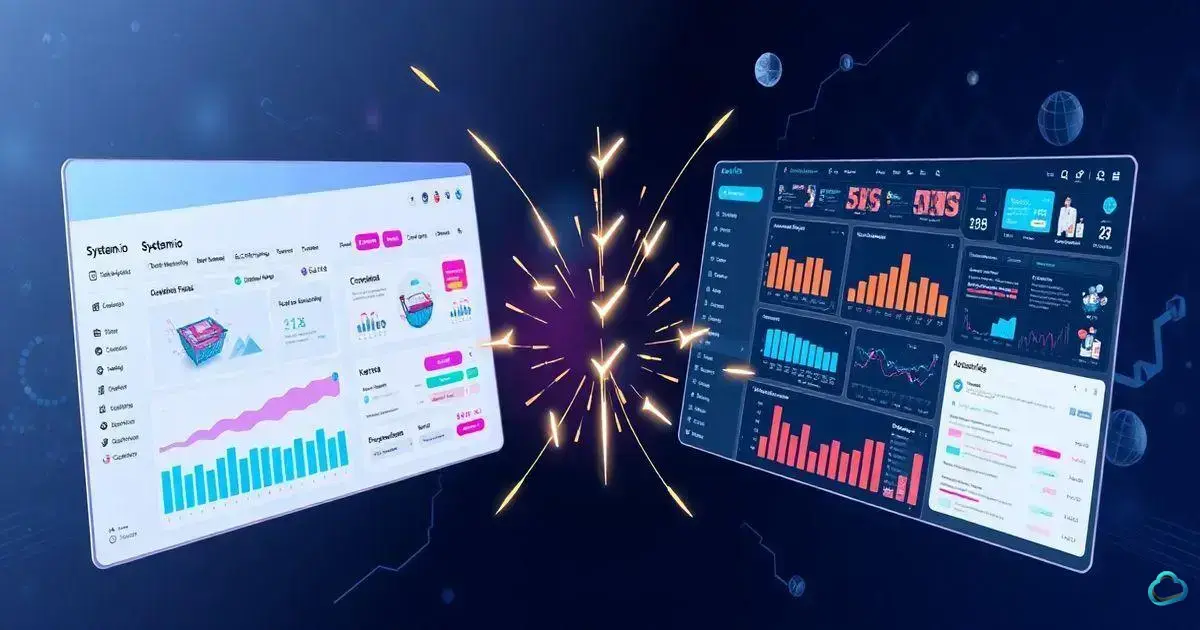Contents
- 0.1 Flexible pricing models in SaaS tools allow businesses to pay based on actual usage, enhancing affordability and scalability. Key factors to consider when choosing these tools include scalability, essential features, reliable customer support, and transparent pricing structures.
- 0.2 Popular SaaS tools like Slack and Zoom offer tiered subscription options, catering to diverse business needs. While these models promote cost efficiency and experimentation, they may also present challenges such as hidden costs and inconsistent features across plans. Understanding these dynamics can help organizations make informed decisions that align with their operational goals.
- 1 1. Understanding Flexible Pricing Models: Define what flexible pricing models are and why they are important for businesses seeking cost-effective SaaS solutions.
- 2 2. Criteria for Choosing SaaS Tools: Discuss key factors to consider when selecting SaaS tools, such as scalability, features, support, and price.
- 3 3. Top SaaS Tools Overview: Provide an overview of the best SaaS tools with flexible pricing, including their primary functions and target users.
- 4 4. Case Studies of Successful Implementations: Present real-world examples of how businesses have successfully implemented these SaaS tools with flexible pricing.
- 5 5. Pros and Cons of Flexible Pricing: Analyze the advantages and disadvantages of using SaaS tools with flexible pricing structures.
- 6 6. Future Trends in SaaS Pricing Models: Explore emerging trends and innovations in SaaS pricing models that may impact future business decisions.
- 7 Conclusion
- 8 Frequently Asked Questions about Flexible Pricing Models in SaaS
- 8.1 What are flexible pricing models in SaaS?
- 8.2 What are the benefits of using SaaS tools with flexible pricing?
- 8.3 What should I consider when choosing SaaS tools?
- 8.4 Can you provide examples of successful SaaS tool implementations?
- 8.5 What are the potential drawbacks of flexible pricing?
- 8.6 What are the emerging trends in SaaS pricing models?
- 8.7 How can I ensure I’m choosing the right SaaS tool with flexible pricing?
Flexible pricing models in SaaS tools allow businesses to pay based on actual usage, enhancing affordability and scalability. Key factors to consider when choosing these tools include scalability, essential features, reliable customer support, and transparent pricing structures.
As businesses increasingly rely on software as a service (SaaS) to streamline operations, choosing the right tools with adaptable pricing options becomes essential. Flexible pricing models allow companies to scale their subscriptions based on usage, features, or team size. In this article, we will delve into the top SaaS tools that stand out for their flexible pricing structures, helping you make an informed decision that aligns with your business goals.
1. Understanding Flexible Pricing Models: Define what flexible pricing models are and why they are important for businesses seeking cost-effective SaaS solutions.
Understanding Flexible Pricing Models
Flexible pricing models in the SaaS (Software as a Service) industry refer to pricing structures that allow companies to choose plans based on their specific needs, usage levels, and budgets. Unlike traditional pricing models with fixed fees, flexible pricing adapts to how businesses utilize the software, enabling them to pay only for what they need.
These pricing models are crucial for businesses for several reasons. Firstly, they provide cost savings, allowing companies to avoid overspending on features they do not use. Secondly, they promote scalability – as a business grows, its software needs may change, and flexible pricing enables companies to easily adjust their subscriptions. Additionally, flexible pricing can foster innovation, encouraging businesses to experiment with different features and tools without a significant upfront investment.
Benefits of Flexible Pricing Models
Cost Efficiency: Flexible pricing ensures that companies are not locked into one pricing tier, allowing them to choose only the features they require, effectively managing their budgets.
Scalability: As businesses evolve, their needs change. Flexible pricing allows for adjustments in subscription levels, accommodating growth or downsizing without penalties.
Encouragement of Use: With flexible pricing, businesses are more likely to explore and use various features of the SaaS tools, leading to better utilization of the software.
Risk Mitigation: Businesses can mitigate the risk of investing in software that may not meet their needs by opting for flexible pricing that allows them to assess and adapt their usage over time.
2. Criteria for Choosing SaaS Tools: Discuss key factors to consider when selecting SaaS tools, such as scalability, features, support, and price.

Choosing the right SaaS tools is a critical step for any business aiming to improve efficiency and productivity. With numerous options available, it’s essential to evaluate various criteria to ensure the selected software aligns with business objectives.
Scalability: One of the most important factors to consider is scalability. Businesses should ensure that the SaaS tool can grow with them, accommodating increased users, transactions, or additional features as needed. Scalable solutions help avoid the hassle of switching tools as business needs evolve.
Features: Evaluate the features offered by the SaaS tool. Identify essential functionalities that your business requires. Compare these features against competitor offerings to ensure you select a solution that not only meets current needs but also has room for future enhancements.
Customer Support: Reliable customer support is crucial for successful SaaS implementation. Investigate the available support channels (such as live chat, phone support, and email), response times, and the provider’s reputation for customer service. Strong support can greatly reduce downtime and improve user experience.
Pricing Structure: Understanding the pricing model is key to making a cost-effective choice. Look for flexible pricing models that align with usage patterns and budget constraints. Analyze not only the upfront costs but also any potential hidden fees, upgrades, or additional charges that may arise as you expand your use of the tool.
Integration Capabilities: Consider how well the SaaS tool integrates with your existing systems and software. Seamless integration is vital for maintaining workflow efficiency and data consistency across different platforms. Check whether the provider offers APIs or existing integrations with the tools you currently use.
User Interface and Experience: The user interface (UI) and overall user experience (UX) play a significant role in user adoption rates. A tool that is easy to use reduces training time and encourages teams to utilize the software effectively. Consider testing demos or free trials to assess usability.
Security and Compliance: Assess the security measures and data compliance standards that the SaaS provider implements. This is particularly important for businesses handling sensitive data or operating in regulated industries. Look for certifications and compliance with standards such as GDPR, HIPAA, or SOC 2.
By evaluating these criteria, businesses can make informed decisions when selecting SaaS tools. A thoughtful approach to choosing the right software ensures alignment with strategic goals while maximizing return on investment.
3. Top SaaS Tools Overview: Provide an overview of the best SaaS tools with flexible pricing, including their primary functions and target users.
In the ever-evolving landscape of software as a service (SaaS), numerous tools offer flexible pricing models designed to adapt to various business needs. Below is an overview of some of the top SaaS tools that stand out due to their versatility, functionality, and user focus.
Top SaaS Tools
Slack: Team Communication and Collaboration
Target Users: Small to large teams, remote workers, and organizations in need of robust communication channels.
Flexible Pricing: Offers a free plan with limited features and a tiered subscription model that scales according to the number of users and advanced features needed.
Zoom: Video Conferencing and Webinars
Target Users: Businesses of all sizes, educators, and anyone needing virtual meeting capabilities.
Flexible Pricing: Provides different plans based on usage and features, including a free tier that allows for short meetings, and paid plans that expand meeting durations and participant limits.
HubSpot: Marketing, Sales, and Customer Service Platform
Target Users: Small to medium businesses seeking an all-in-one solution for inbound marketing, CRM, and customer service.
Flexible Pricing: Offers a free CRM and various paid tiers for marketing, sales, and service hubs that accommodate growing functionalities as the business scales.
Asana: Project Management and Task Tracking
Target Users: Teams looking for organized project execution and task management.
Flexible Pricing: Includes a free basic version and several subscription tiers that offer additional features such as timeline views, custom fields, and reporting.
Shopify: E-commerce Platform
Target Users: Entrepreneurs and businesses of all sizes wanting to set up an online store.
Flexible Pricing: Provides various plans with different functionality levels, allowing users to choose based on their e-commerce needs and budget.
Trello: Task and Project Management
Target Users: Individuals, teams, and projects in any industry looking for visual organization of tasks.
Flexible Pricing: Offers a free version with essential features and flexible paid plans that unlock advanced features like automation and enhanced integrations.
These SaaS tools not only offer vital functionalities for various business needs but also provide flexible pricing options that allow organizations to adapt their usage as they grow. Selecting the right tool can enhance collaboration, streamline operations, and ultimately contribute to achieving business objectives.
4. Case Studies of Successful Implementations: Present real-world examples of how businesses have successfully implemented these SaaS tools with flexible pricing.

4. Case Studies of Successful Implementations
Real-world examples of businesses successfully implementing SaaS tools with flexible pricing models highlight the versatility and effectiveness of these solutions. Below are several case studies that showcase how companies are maximizing their outcomes through smart software choices.
Case Studies
Trello
A digital marketing agency integrated Trello into their project management processes to improve team collaboration and task tracking. They started with the free version and later upgraded to a Business Class plan as their projects expanded.
Result: The agency reported a 30% increase in project completion rates and significantly improved communication among team members.
HubSpot
A small startup used HubSpot’s free CRM to manage its lead generation and customer interactions. As the startup grew, it adopted the Marketing Hub subscription to leverage additional marketing tools.
Result: With the comprehensive CRM and marketing tools, the startup increased its lead conversion rate by 25% within six months.
Slack
A tech company implemented Slack to enhance communication among remote teams. Initially starting on the free plan, they transitioned to a paid plan when they needed more integrations and advanced features.
Result: The company noted a marked improvement in team productivity, with faster decision-making and enhanced collaboration across departments.
Zoom
An online educational institution adopted Zoom for virtual classes, starting with the free basic plan. As their student enrollment grew, they upgraded to a Pro plan to accommodate more participants and longer meetings.
Result: The institution was able to scale its online programs, resulting in a 40% increase in student enrollment, while maintaining high engagement through interactive classes.
Shopify
A local retailer transitioned to online sales by using Shopify. They began with the basic plan to test the online market and later upgraded to a more comprehensive plan as their sales escalated.
Result: The retailer achieved a 150% increase in sales within the first year of launching their online store, expanding their customer base beyond local confines.
Asana
A consulting firm deployed Asana to manage multiple client projects. They started with the basic free version, but quickly adopted a premium plan to utilize advanced features such as timelines and reporting.
Result: The firm improved project tracking efficiency by 35%, allowing them to allocate resources more effectively and meet tight deadlines.
These case studies illustrate the real-world benefits of implementing SaaS tools with flexible pricing models. By aligning their business needs with the right software, these companies have witnessed substantial improvements in operational efficiency, communication, and overall performance.
5. Pros and Cons of Flexible Pricing: Analyze the advantages and disadvantages of using SaaS tools with flexible pricing structures.
5. Pros and Cons of Flexible Pricing
Flexible pricing models for SaaS tools offer unique benefits and drawbacks that businesses should carefully consider before making their choice. By understanding the pros and cons, organizations can determine if these pricing structures align with their operational needs and budget constraints.
Pros
Cost Savings: Flexible pricing allows businesses to select plans that fit their actual usage patterns, preventing overspending on unused features and services. This pay-as-you-go approach can lead to significant savings.
Scalability: As businesses grow, their needs for software can change. Flexible pricing models allow organizations to easily scale their subscriptions up or down based on user count, feature requirements, or usage levels, ensuring they only pay for what they need.
Encourages Experimentation: With lower financial commitment, businesses feel more comfortable exploring different features and tools. This can foster innovation and lead to the discovery of solutions that enhance productivity and efficiency.
Risk Mitigation: Flexible pricing options help mitigate risks associated with long-term contracts or upfront payments, allowing businesses to change providers or adapt their services as necessary without significant financial repercussions.
Greater Customization: Many flexible pricing models offer tiered options, enabling businesses to customize their use of the software according to their specific needs and budget, creating a more tailored solution.
Cons
Potential for Hidden Costs: While flexible pricing can be advantageous, it sometimes leads to unexpected costs if additional features or user levels are required beyond the initial plan. Businesses need to be vigilant to understand the full pricing structure.
Complexity in Management: Managing subscriptions across different tiers and understanding what each plan includes can become complex, particularly for larger organizations with multiple teams and departments using various tools.
Overwhelm from Options: Having multiple pricing tiers and customization options can overwhelm businesses, making it challenging to determine the best plan for their needs, potentially leading to indecision or suboptimal choices.
Usage Fluctuations Impacting Costs: For businesses that experience variable or unpredictable usage patterns, costs can vary significantly month-over-month, making budgeting and forecasting more difficult.
Inconsistent Features Across Plans: Often, certain key features may only be available in higher-tier plans, which may not always justify the cost. Businesses may find themselves needing to upgrade to access critical functionalities.
Analyzing the pros and cons of flexible pricing structures helps businesses navigate their choices in the SaaS landscape. While these models offer cost savings, scalability, and customization, they also come with potential hidden costs and complexities. It’s crucial for organizations to weigh these factors carefully against their specific needs and goals before committing to a SaaS tool.
6. Future Trends in SaaS Pricing Models: Explore emerging trends and innovations in SaaS pricing models that may impact future business decisions.

As the SaaS industry continues to evolve, so do the pricing models that software providers use. Understanding emerging trends in SaaS pricing can help businesses anticipate changes that may influence their purchasing decisions and operational strategies.
Usage-Based Pricing: Increasingly, SaaS companies are adopting usage-based pricing models, where customers are charged based on their actual usage of the software. This trend allows businesses to align costs directly with their level of engagement and can be particularly appealing to organizations looking to minimize expenses.
Tiered Pricing Models with Pay-as-You-Go Features: Hybrid pricing models combining tier-based access with pay-as-you-go elements are becoming common. These models offer customers the flexibility to choose a base subscription and pay additionally for extra usage or features, providing a balance between predictability and adaptability.
Freemium to Premium Upsell Strategies: Many SaaS tools now offer freemium models where basic features are free, encouraging widespread adoption. These companies then focus on effectively upselling premium features or plans to convert free users into paying customers, creating a smooth transition as needs grow.
Dynamic Pricing Techniques: Similar to pricing models in industries like travel and hospitality, dynamic pricing is gaining traction in the SaaS sector. Prices may vary based on factors such as demand, customer behavior, or market conditions, enabling providers to optimize revenue and customers to benefit from tailored pricing.
Bundled Services and Cross-Selling Opportunities: SaaS companies are increasingly offering bundled services that combine multiple tools or features at a discounted rate. This model encourages customers to purchase more while simplifying their software ecosystem, leading to increased customer loyalty.
Increased Focus on Value-Based Pricing: More firms are shifting toward value-based pricing models, determining pricing based on the perceived value and outcomes the software provides to the customer, rather than just the cost of delivering the service. This approach encourages companies to continuously enhance their offerings to justify pricing.
Emerging trends in SaaS pricing models indicate a move towards greater flexibility, personalization, and alignment with customer value. By staying informed about these developments, businesses can make strategic decisions that foster growth, ensure cost-effectiveness, and enhance their software investments.
Conclusion
In conclusion, the exploration of SaaS tools with flexible pricing models highlights the significant advantages these solutions can offer to businesses of all sizes. By understanding the criteria for choosing the right tools, analyzing case studies, and evaluating the pros and cons of flexible pricing, organizations can make informed decisions tailored to their specific operational needs.
Key Takeaways
Flexible pricing models provide opportunities for cost savings, scalability, and customization, making them appealing to both small startups and large enterprises.
However, businesses must remain vigilant about potential hidden costs, complexities in management, and the risk of being overwhelmed with options.
Emerging trends such as usage-based pricing, bundled services, and value-based pricing signal a shift toward more consumer-centric approaches, which will be vital for businesses to understand as they navigate the SaaS landscape.
Final Thoughts
As the SaaS industry continues to evolve, adapting to these changes and harnessing the benefits of flexible pricing will empower businesses to enhance their operational efficiencies, drive growth, and ultimately achieve their strategic objectives.
Frequently Asked Questions about Flexible Pricing Models in SaaS
What are flexible pricing models in SaaS?
Flexible pricing models refer to pricing structures in Software as a Service (SaaS) that allow businesses to choose plans based on their specific needs, usage levels, and budgets, rather than fixed fees. This approach helps companies pay only for what they use.
What are the benefits of using SaaS tools with flexible pricing?
Benefits include cost savings, scalability to grow with your business, encouragement of experimentation with various features, risk mitigation from long-term commitments, and greater customization to meet unique organizational needs.
What should I consider when choosing SaaS tools?
Key factors include scalability, essential features, customer support quality, pricing structure, integration capabilities with existing systems, user interface and experience, and security and compliance measures.
Can you provide examples of successful SaaS tool implementations?
Yes, examples include a digital marketing agency using Trello, a startup leveraging HubSpot’s CRM, and an online educational institution adopting Zoom, all of which improved efficiency and engagement through their chosen tools.
What are the potential drawbacks of flexible pricing?
Drawbacks may include hidden costs, complexity in subscription management, overwhelming options, unpredictable costs due to usage fluctuations, and inconsistent features across different pricing tiers.
What are the emerging trends in SaaS pricing models?
Emerging trends include usage-based pricing, tiered pricing with pay-as-you-go features, freemium to premium upsell strategies, dynamic pricing, bundled services, and increased focus on value-based pricing to better reflect customer outcomes.
How can I ensure I’m choosing the right SaaS tool with flexible pricing?
Conduct thorough research, compare different SaaS options based on your specific needs, review case studies for real-world insights, and stay updated on industry trends to make an informed decision.






